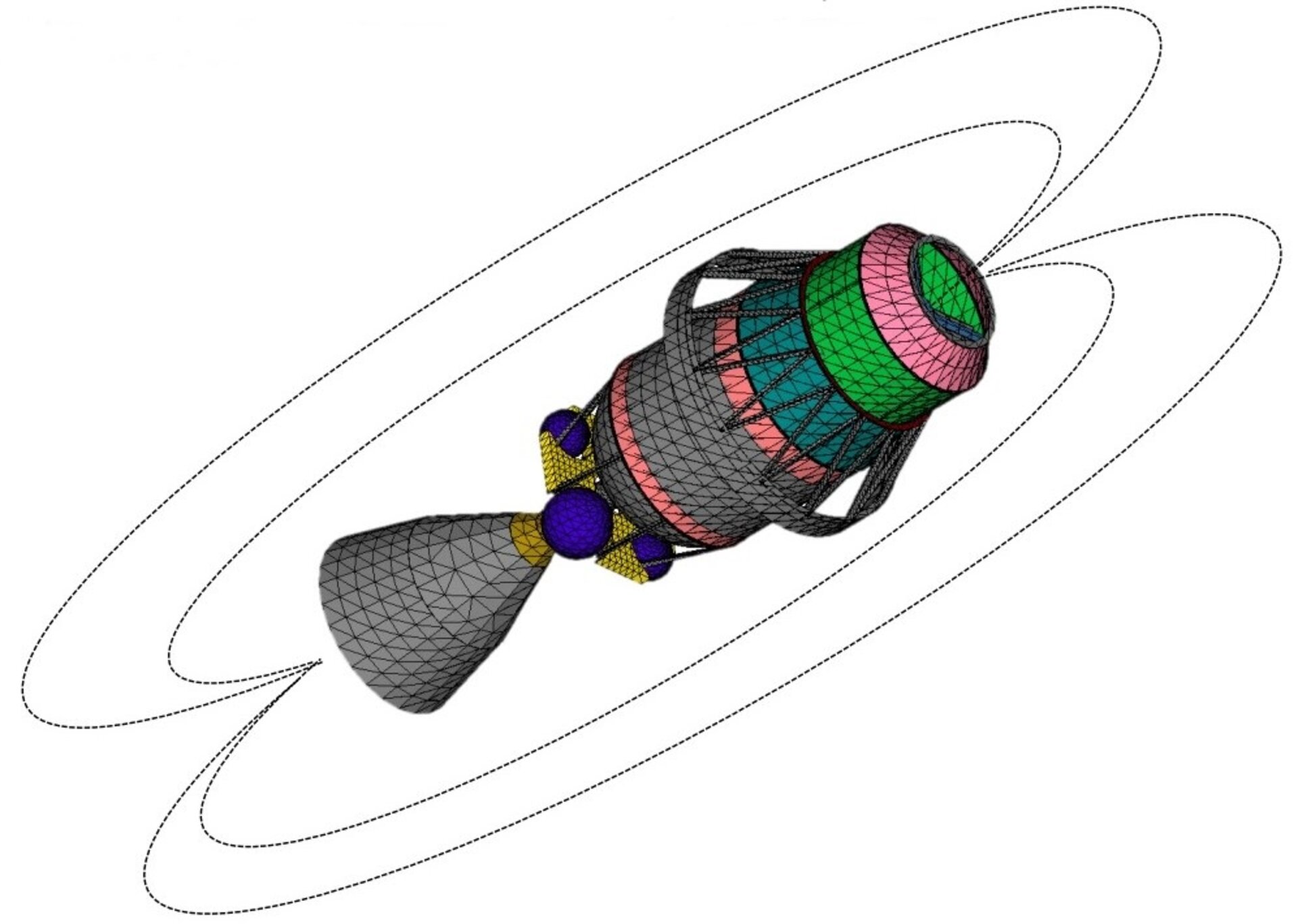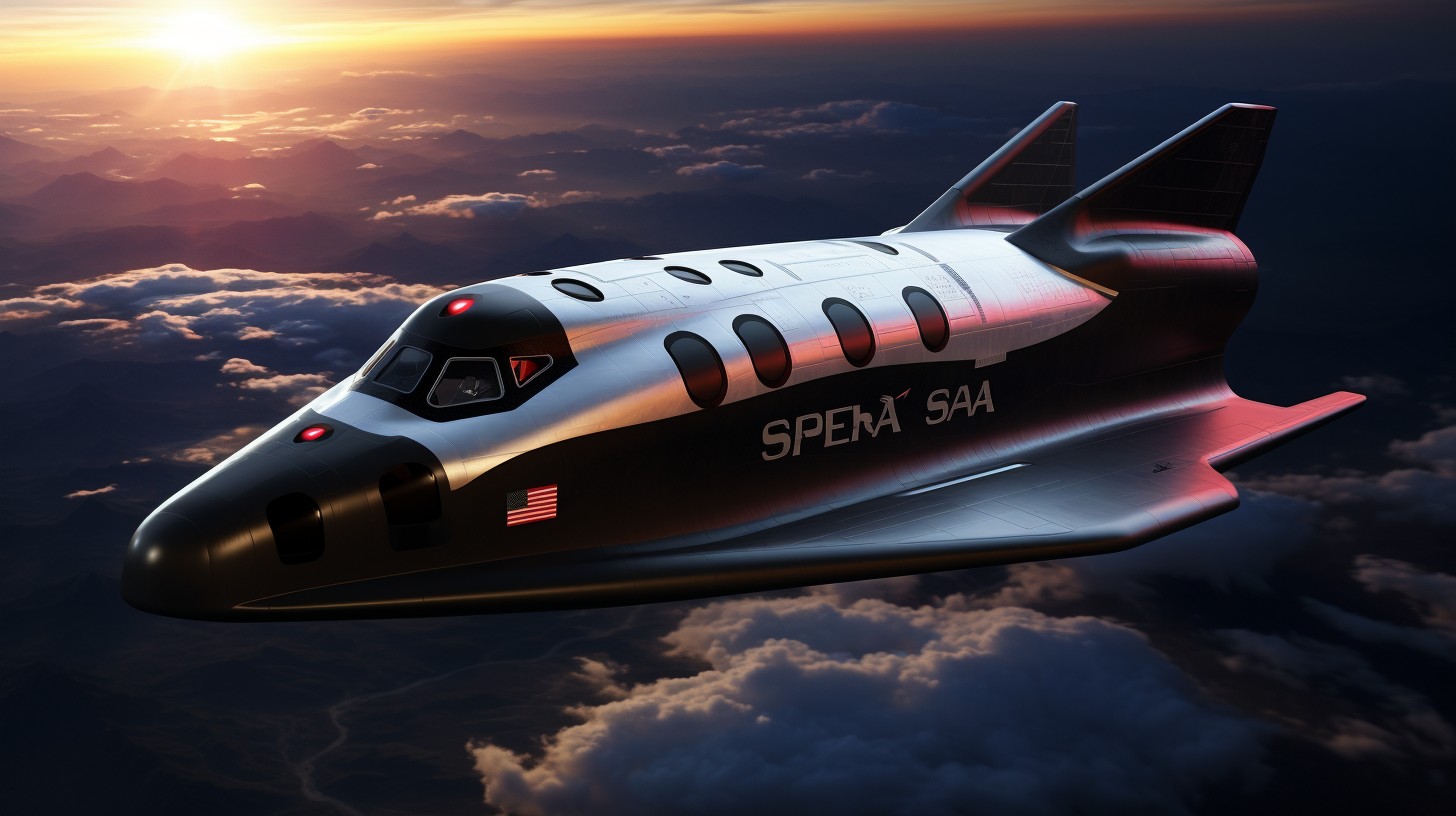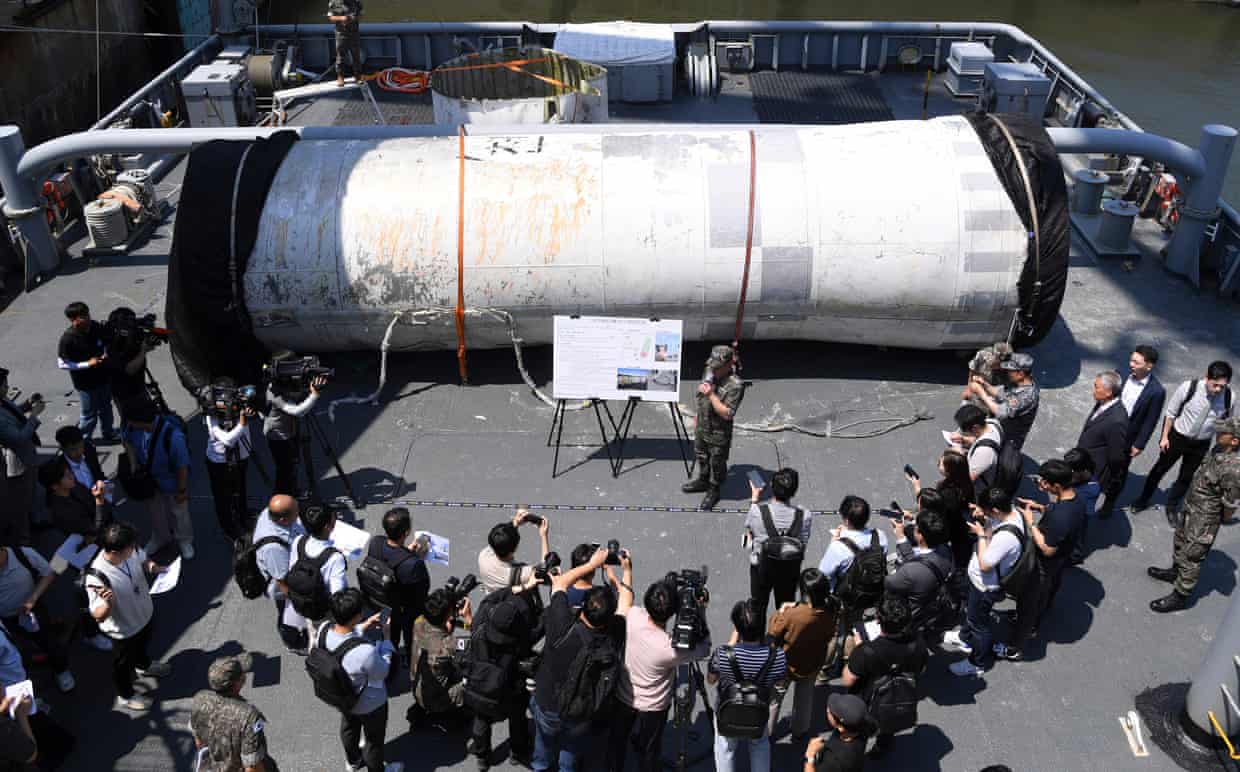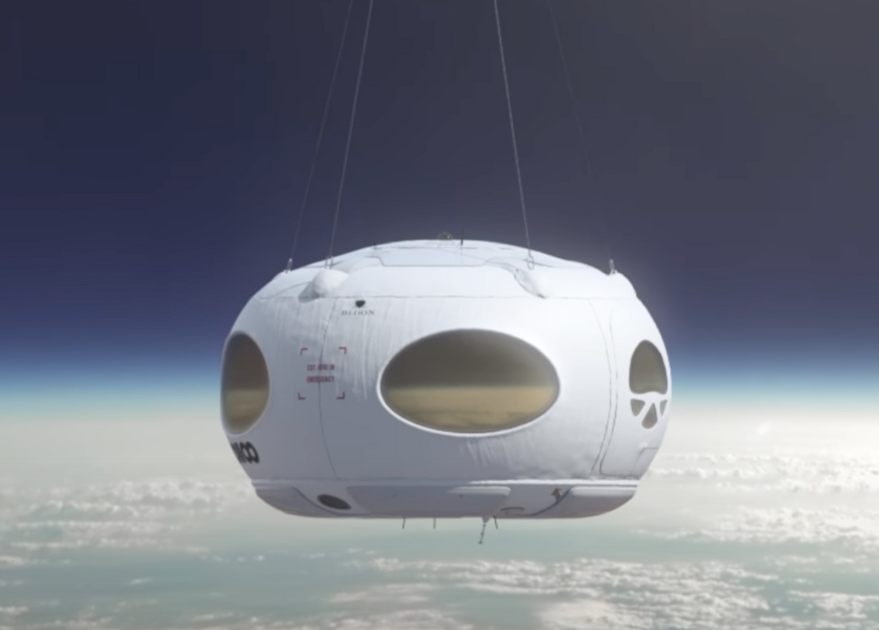TOP NEWS
North Korea Rocket Explodes During Spy Satellite Launch, And Meteor Hunters Caught It On Camera: Report
The first stage of a North Korean rocket apparently exploded Tuesday (Nov. 21) during a purported spy satellite launch, a new video suggests.
A camera at South Korea’s Yonsei University, usually used for tracking meteors or shooting stars, showed the first stage of the North Korean Chollima-1 rocket appearing to erupt and spread debris, Reuters reported Friday (Nov. 24).
Read more at: yahoo news
Spacecraft Are Sprinkling the Stratosphere with Metal
With life spans ranging from years to centuries, many of the satellites we launch into orbit around Earth come back down—roughly 200–300 objects annually. And though we have been keeping an eye out for this falling space debris, the stratosphere has been taking most of the hit, according to new research.
When spacecraft burn up in the upper atmosphere on reentry, metals making up the hardware don’t just disappear. “We have now found where they go: the stratosphere,” said atmospheric chemist Daniel Murphy at NOAA. Roughly 10% of the stratosphere’s large aerosol particles are contaminated with these metals.
Read more at: EOS
SPACE HAZARDS & STM
A Satellite’s Death Spiral
Down on the ground, death equals stillness – but not in space. Abandoned satellites are prone to tumble in unpredictable ways and an ESA project with the Astronomical Institute of the University of Bern sought to better understand this behaviour.ESA’s Clean Space initiative has plans to remove dead satellites from highly trafficked orbits. The preferred method of ‘Active Debris Removal’ involves grabbing the target object, in which case knowledge of its precise orientation and motion will be vital. So the need is clear to understand the tumbling that almost all satellites and rocket bodies undergo after their mission end-of-life.
Read more at: ESA

Earth Slammed By Ultra-Powerful ‘Goddess Particle’ Cosmic Ray, And We Have No Idea Where It Came From
Researchers have detected one of the most powerful cosmic rays ever seen slamming into Earth — but they have no idea what caused it or where it came from. The extremely energetic particle, which has been named after a Japanese goddess, arrived from the direction of a void in the universe where almost nothing is known to exist, according to new research.
Cosmic rays are highly energetic particles, mainly consisting of protons or helium nuclei, that are constantly raining through every square inch of the universe (including our bodies). But a small subsection of cosmic rays, which hit Earth roughly once per square mile every year, are accelerated to even greater energy levels by some of the universe’s most intense phenomena.
Read more at: livescience
Unseen Asteroid on a Potential Collision Course with Earth
An asteroid, unnoticed since its discovery in 2007, has now grabbed the attention of scientists as a potential threat to Earth in the year 2024. Known as 2007 FT3, this ‘lost asteroid’ made only a brief appearance on the astronomical stage with a mere 1.2 days of tracking before evading further observation. NASA’s vigilant eyes in the sky, the Center for Near Earth Object Studies (CNEOS), has taken the responsibility to monitor such cosmic wanderers closely, with over 32,000 near-Earth asteroids (NEAs) and more than 120 close-passing comets on their watch list.
Read more at: ts2
NASA Warns Solar Storm Might Hit Earth Today Amid Increased Sun Activity
In the past week, the sun has shown increased activity, with a surge in sunspots and the launch of several coronal mass ejections (CMEs) on a daily basis. Earth is continuously experiencing solar storms and there is a possibility of another one approaching today, as per Newsweek. According to NASA, one of these coronal mass ejections (CMEs) may be on a collision course with Earth.
When a CME hits the Earth, it can cause a geomagnetic storm, which is a disturbance of the Earth’s magnetic field and atmosphere by the solar plasma.
Read more at: NDTV
NASA Reacts To Reports About An Asteroid Hitting Earth In 2024
Nasa has quelled fears that an asteroid could hit Earth in the next few years. GB News and other media outlets reported that the asteroid named 2007 FT3 was first spotted floating through space in 2007. However, scientists reportedly soon lost its flight path with no idea where it went. After this, 2007 FT3 has been categorised as a “lost asteroid”. According to GB News, Nasa said there was a 0.0000096 percent — or 1 in 10 million — chance of it striking our planet on March 3, 2030.
Read more at: yahoo finance
COMMERCIAL SPACE
SpaceX Continues Aerial Endeavors with Starlink Satellite Deployment
SpaceX, the aerospace innovator led by Elon Musk, has once again marked its prominence in the space sector with the recent launch of 23 Starlink satellites. This strategic move came on the heels of a significant trial involving the Starship aircraft, known to be the most potent rocket in existence. The excitement was palpable on Saturday when the towering rocket roared into the skies from the Starbase facility in Texas. On its ambitious journey, it soared up to an impressive altitude above the Earth, proving the prowess of SpaceX’s cutting-edge technology.
Read more at: ts2
Sierra Space’s Dream Chaser: Revolutionizing Space Travel with Final Touches
The aerospace industry is buzzing with anticipation as Sierra Space completes its cutting-edge spaceplane, Dream Chaser. Boasting custom ceramic tiles that clad its wings and body, this marvel of engineering is designed to withstand the fiery descent through Earth’s atmosphere. The fuselage, gracefully lined with foldable wings akin to those on a combat aircraft, allows Dream Chaser to snugly fit within a launch vehicle.
As the spacecraft nears completion, technicians perform intricate work on the internal ducts critical for the environmental control system.
Read more at: ts2

MDA Gets $131 Million From Mystery NGSO Constellation Customer
An undisclosed customer is paying MDA 180 million Canadian dollars ($131 million) to start engineering a non-geostationary constellation of 36 satellites.
The deal could be worth at least four times more if the Canadian space hardware specialist advances to become prime contractor for the constellation next year, MDA said in a brief Nov. 17 news release.
MDA spokesperson Amy MacLeod declined to give more details on the Authorization to Proceed (ATP) contract, which kicks off early work for a satellite project such as procuring long-lead items.
Read more at: spacenews
SpaceX’s Epic Starship Liftoff Didn’t Damage Launch Pad, Elon Musk Says
SpaceX’s Starship launch pad appears to have passed its second trial by fire.
The pad, at SpaceX’s Starbase site in South Texas, took a beating on April 20, during the first-ever test flight of a fully stacked Starship vehicle. The huge rocket’s 33 first-stage Raptor engines blasted out a big crater beneath the pad that day, sending chunks of concrete and other debris high into the Texas sky.
Read more at: space.com
Launch Roundup: SpaceX On Pace To Hit 100 Launches In 2023, Soyuz To Launch Bars-M
Following a busy week for SpaceX with the launch of two Starlink missions and the second launch of Starship, SpaceX is currently on track to meet its 100 launch goal of 2023. The first launch of the week took place on Wednesday, with North Korea successfully placing the Manligyeong 1 satellite into orbit. Later that day, Falcon 9 placed 23 Starlink satellites into low-Earth orbit (LEO). On Thursday, China launched three SatNet test satellites, followed on Saturday by the Russian Space Force launching a Bars-M payload on a Soyuz 2.1a. On Monday, SpaceX launched its second Starlink mission of the week: Starlink Group 6-30.
Read more at: NASA spaceflight
The Complex Neutrality Of Commercial Space Actors In Armed Conflict
During an international armed conflict, commercial space actors under the jurisdiction or control of a third, neutral state may find themselves implicated in the conflict in various ways, which could increase tensions and trigger misunderstandings between a belligerent and neutral state and risk the latter losing its neutral status.In this post, part of a series on War, law and outer space, Professor Guoyu Wang of the Academy of Air, Space Policy and Law at the Beijing Institute of Technology discusses the potential legal issues raised by such involvement under both neutrality law and international humanitarian law (IHL), including the significance of legal interpretation of the lex lata for space security governance.
Read more at: ICRC
ArianeGroup Begins Testing Prototype Of Multirole Susie Upper Stage
ArianeGroup has started testing what it considers to be a versatile answer to numerous challenges facing European spaceflight.
ArianeGroup quietly began testing a small demonstrator for its Smart Upper Stage for Innovative Exploration (SUSIE) in recent weeks. The vehicle was announced at the International Astronautical Congress in September 2022, but little more had been heard of the internally-funded project.
Read more at: spacenews
🌍🚀🌕 The Lunar Gateway that @NASA and @ESA are developing will be deployed in the 2030s. It will serve as a base camp for activity on the lunar surface. In this context, #SUSIE could turn into a “space train”. 🚂✨ #ArianeGroup @arianespace pic.twitter.com/1rfXkLplCE
— ArianeGroup (@ArianeGroup) November 15, 2023
SCIENCE & TECHNOLOGY
NASA Is Pausing All Mars Missions, Effective Immediately. Here’s Why.
Mars disappeared from the sky over Earth on Saturday (Nov. 18) when the Red Planet was apparently swallowed by the sun.
Don’t panic, this disappearance may look dramatic but it is actually the result of Mars passing to the opposite side of the sun to Earth during an event that astronomers call solar conjunction.
Read more at: livescience
Hydrogen Detected In Lunar Samples, Points To Resource Availability For Space Exploration
U.S. Naval Research Laboratory (NRL) researchers have discovered solar-wind hydrogen in lunar samples, which indicates that water on the surface of the moon may provide a vital resource for future lunar bases and longer-range space exploration. Space-based resource identification is a key factor in planning for civilian- and government-led space exploration.
“Hydrogen has the potential to be a resource that can be used directly on the lunar surface when there are more regular or permanent installations there,” said Dr. Katherine D. Burgess, geologist in NRL’s Materials Science and Technology Division. “Locating resources and understanding how to collect them prior to getting to the moon is going to be incredibly valuable for space exploration.”
Read more at: phys.org
Does Spaceflight Increase Men’s Risk Of Erectile Dysfunction?
During missions into space, astronauts are exposed to high levels of galactic cosmic radiation and weightlessness. Simulation experiments in male rats indicated that these aspects of spaceflight can negatively affect vascular tissues relevant to erectile dysfunction, even after a period of long-term recovery.
The research, which is published in The FASEB Journal, indicated that vascular alterations are induced by relatively low doses of galactic cosmic radiation and to a lesser extent simulated weightlessness, primarily through increases in oxidative stress. Treatment with different antioxidants could counter some of these effects.
Read more at: eurekalert
SpaceX Launches “Limitless” ‘Zero Fuel’ Engine Into Space
SpaceX has launched a new type of zero-fuel propulsion system into orbit, which its creators claim will revolutionise the space industry.The Quantum Drive engine, built by US startup IVO Ltd, was fitted on a microsatellite that entered orbit aboard SpaceX’s Transporter 9 mission, which lifted off from the Vandenberg Space Force Base in California.IVO claims that its technology is the world’s first commercially viable pure electric propulsion technology that works in space, drawing “limitless power for propulsion from the Sun”.
Read more at: independent
Scientists Find Hydrogen In Apollo Moon Rocks, Suggesting Astronauts Can Harvest Lunar Water
A fresh analysis of moon rocks brought home during the Apollo missions has, for the first time, revealed the presence of hydrogen. This finding suggests future astronauts could someday use water available right on the moon for life support and rocket fuel.
Researchers with the U.S. Naval Research Laboratory (NRL), to whom NASA provided the lunar samples for a research study, announced last week that they discovered hydrogen in lunar soil sample 79221. The detected hydrogen is thought to have been brought into existence by incessant showers of solar wind, and even comet strikes, on the moon.
Read more at: space.com
Satellites Watch Russia’s Tallest Volcano Spew 1,000-Mile-Long Plume Of Smoke (Photos)
Eurasia’s tallest volcano has violently erupted, throwing a 1,000-mile-long (1,600 kilometers) cloud of dust and ash into the air, new NASA satellite images show.
Klyuchevskoy, sometimes referred to as Klyuchevskaya Sopka, is an active stratovolcano in Russia’s Kamchatka Peninsula, which is home to more than 300 other volcanos. Klyuchevskoy’s peak stands at 15,584 feet (4,750 meters) above sea level, making it taller than any other volcano in Asia or Europe, according to the Kamchatka Volcanic Eruption Response Team (KVERT).
Read more at: space.com

SPACE POLICY
How China Ties Space Projects In Africa With Climate And Security Priorities
The centre, which is China’s first overseas BeiDou Satellite (BDS) Navigation System built and is funded by China and the Tunisia-based Arab Information and Communication Technology Organisation, “is strategically positioned to promote international exchanges”.
Read more at: SCMP
Japan To Set Up $6.7bn JAXA Fund To Develop Space Industry
Japan’s cabinet on Monday approved a bill to set up a 1 trillion yen ($6.7 billion) fund for JAXA, the country’s space agency, as a way to catapult the country’s private sector into the global race for new rocket and satellite technologies.
The bill aims to create a trillion-yen endowment over the next 10 years that the Japan Aerospace Exploration Agency would dip into to provide long-term support to startups, other private-sector companies and universities.
Read more at: nikkei asia
Australia And Space: A Step Together For The Whole Nation
Australia’s reliance on space-based and space-enabled technologies is integral to the country’s way of life, especially in navigating the varied challenges presented by the climate, cultivating a diverse and dynamic workforce, and confronting evolving security threats.
But recent government decisions, such as the cancellation of a space mission, cast doubt on the commitment to excel in this sector.
Read more at: lowyinstitute
Moonshot vs. Long March: Contrasting the United States’s and China’s Space Programs
On the morning of November 2, 2023, the Gobi Desert’s silence was shattered: From a remote launchpad at the Jiuquan Satellite Launch Center (中国酒泉卫 星发射中心), the Hyperbola-2 (双曲线二号), a slender rocket bearing the iSpace emblem (星际荣耀), surged upwards, before gracefully alighting back on Earth (iSpace WeChat, November 2; CNSA, November 2). This suborbital hop marked a major achievement for iSpace as the company progresses towards developing reusable medium-lift rockets. The test demonstrated key technologies like the methalox engine and landing capabilities that will enable iSpace’s larger reusable rocket plans with Hyperbola-3.
Read more at: jamestown
Space Governance Lab Confronts ‘Final Frontier’ in Policy and Security
In the tradition of its founder Elinor Ostrom, whose groundbreaking research on the governance of “the commons” earned a Nobel Memorial Prize, the Indiana University Ostrom Workshop has long been a gathering place for scholars who specialize in public spaces. And no public space is more public, or more spacious, than outer space.
In recognition of this “final frontier” in the field, the Ostrom Workshop recently established the Space Governance Lab. The goal is to explore the complex mix of challenges — political, legal, technical, social — that result from so many new players, including governments and private corporations, rushing into the once largely empty space beyond the Earth’s atmosphere.
Read more at: IU news
Europe’s Space Chief Calls For Greater UAE Collaboration
The European Space Agency is an awakening giant that wants to “further explore co-operation opportunities” with the UAE’s programme, its chief told The National.Dr Josef Aschbacher also suggested the ESA could collaborate on a second Rashid lunar mission to fly a UAE lander to the Moon.With the space agency’s budget rising to almost $8 billion following a 17 per cent uplift this year, Europe has “woken up a sleeping beauty” in its ambition to explore space, the director general said.Part of that is a major astronaut programme that will likely see manned ESA flights to the Moon “and beyond” within the next decade, with deep exploration of the lunar surface expected.
Read more at: national news
SPACE DEFENCE
Fifth Force: Is China Adding Hypersonic ‘Near-Space Command’ To Its Military For ‘Precise And Merciless’ Attacks?
The new force joins the People’s Liberation Army’s army, air force, navy and rocket branches.
“The near-space combat force is in the process of rapid development. The establishment of relevant units is not yet mature, and combat operations have not been standardised. The understanding of near-space combat command needs to be deepened,” said the researchers from the National University of Defence Technology.
Read more at: SCMP
Japan Warns North Korea After Getting Notice of Satellite Launch
Prime Minister Fumio Kishida called on North Korea to halt its plans to launch a satellite after Japan received a notice on fields where debris from a rocket may fall at sea.
Kishida told reporters Tuesday that a launch would be in violation of UN Security Council resolutions, and his government would work with the US and South Korea to deal with the matter.
Japan’s Coast Guard received a notice from a country it didn’t identify that warned of a possible rocket launch from Wednesday to Dec. 1 that gave three areas where debris may fall. Two were west of the Korean Peninsula and another was east of the Philippine island of Luzon.
Read more at: yahoo news
South Korea To Partially Suspend Military Deal With North After Launch Of Spy Satellite
South Korea has moved to partially suspend a 2018 military agreement with North Korea, which said it had successfully launched its first military spy satellite into orbit, the Yonhap news agency reported.
“North Korea is clearly demonstrating that it has no will to abide by the 19 September [2018] military agreement designed to reduce military tension on the Korean Peninsula and to build trust,” the South’s prime minister, Han Duck-soo, told an extraordinary cabinet meeting that approved suspending the deal.
Read more at: Guardian

US Space Force Wants To Track ‘Abnormal Observables’ With Unknown Origins In Earth’s Orbit
The U.S. Space Force wants to be able to identify and track mysterious objects in orbit.The Space Force’s Space Training and Readiness Command, or STARCOM, which is tasked with educating and training U.S. Space Force personnel, recently published a document titled “Space Doctrine Publication 3-100, Space Domain Awareness” that outlines what space domain awareness (SDA) is and how to establish and maintain it. In a nutshell, SDA means being able to identify, understand, track and maintain custody of all of the various objects in orbit around Earth.
Read more at: space.com
Where The Naysayers Are Wrong When It Comes To A Space National Guard
When lawmakers come back from their Thanksgiving break, a key priority will be negotiations on the Pentagon’s annual authorization bill. Within that, Congress could decide to establish a Space National Guard (SNG) -— or not. In the op-ed below, Brig. Gen. Mike Bruno, chair of the Space task force at the National Guard Association of the United States and director of the Joint Staff of the Colorado National Guard, argues in favor of an SNG and points out where he thinks critics are a bit lost in space.
Read more at: breaking defense
Space Force Taps 4 Firms To Vie For Missile Warning C2 Prototype
The Space Force’s complex, and somewhat challenged, program to develop a new ground system for its next generation of missile warning satellites is inching forward, with four firms set to compete for development of a command and control (C2) system prototype.NSTXL, which manages the Space Systems Command (SSC) Space Enterprise Consortium (SpEC) program, today announced awards to Ball Aerospace, Parsons, General Dynamics and Omni Federal for the Future Operationally Resilient Ground Evolution Command and Control (FORGE C2) prototype project. Each award is worth $9.75 million over 16 months, according to a NSTXL press release.
Read more at: breaking defense

VARIOUS
Chinese Rocket That Crashed Into The Moon Was Carrying A Mystery Object
A piece of human-made space junk slammed into the far side of the moon last year, initially leaving scientists stumped. After some astronomical detective work, new research argues that it was most likely a Chinese booster rocket – with an unknown object attached to it.
On March 4, 2022, a mysterious object known as WE0913A crashed into the lunar surface, leaving behind an unusually shaped double-crater. While it was initially suspected to be part of a SpaceX Falcon 9 rocket, later evidence suggested it was a booster as part of the Chang’e 5-T1 lunar mission. China, however, denied any involvement.
Read more at: IFLscience
This Is the Largest Blunt Body to Reenter Earth’s Atmosphere, It Brought Back a Mystery
The word is an acronym for Low-Earth Orbit Flight Test of an Inflatable Decelerator, and in essence it stands to represent a new approach to spacecraft heat shields – you know, that piece of hardware meant to protect a space vehicle as it makes its fiery re-entry in a planet’s atmosphere.
Heat shields are crucial in ensuring the survival of spacecraft and the people and hardware during re-entry. In most places of this solar system, coming down from space to the surface entails surviving extreme conditions.
Read more at: auto evolution

Earth Just Received A Laser-Beamed Message From 16 Million Kilometers Away
A deep space experiment traveling on NASA’s Psyche spacecraft has just beamed a message via laser to Earth from far beyond the Moon for the first time, an achievement that could transform how spacecraft communicate.
In the farthest-ever demonstration of this type of optical communication, the Deep Space Optical Communications (DSOC) beamed a near-infrared laser encoded with test data from its position around 16 million kilometers (10 million miles) away – which is around 40 times farther than the Moon is from Earth – to the Hale Telescope at Caltech’s Palomar Observatory in California.
Read more at: IFLscience
Viasat Warns Satellite Power Limit Review Would Hurt GEO Innovation
A proposal to review satellite transmission power limits risks curtailing investments and innovation in geostationary orbit (GEO) where space companies such as Viasat operate, an executive for the operator warned.
The move to review Equivalent Power Flux Density (EPFD) limits, affecting how powerful non-geostationary (NGSO) satellite signals should be to avoid disrupting GEO spacecraft, is up for debate at the four-week WRC-23 conference that kicked off Nov. 20 in Dubai to update global spectrum rules.
Read more at: spacenews
Halo Space, Eos X And Arthur D. Little Spain Indicted For Unlawful Use Of Zero 2 Infinity’s Trade Secrets
Halo Space, Eos X Space Technologies Corp. and Arthur D. Little Spain were indicted Oct. 31 in Madrid on charges of unlawful discovery of the trade secrets of Spanish high-altitude balloon company Zero 2 Infinity.
The case stems from Zero 2 Infinity’s allegations that the people hired to raise money for its space tourism business established two competing firms based on Zero 2 Infinity’s intellectual property.
Read more at: spacenews




















![A trajectory analysis that used a computational fluid dynamics approach to determine the likely position and velocity histories of the foam (Credits: NASA Ref [1] p61).](http://www.spacesafetymagazine.com/wp-content/uploads/2014/05/fluid-dynamics-trajectory-analysis-50x50.jpg)


